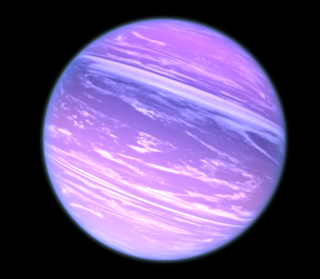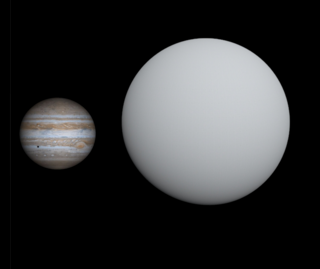The Hungarian Automated Telescope Network (HATNet) project is a network of six small fully automated "HAT" telescopes. The scientific goal of the project is to detect and characterize extrasolar planets using the transit method. This network is used also to find and follow bright variable stars. The network is maintained by the Center for Astrophysics | Harvard & Smithsonian.
The XO Project is an international team of amateur and professional astronomers tasked with identifying extrasolar planets. They are led by Peter R. McCullough of the Space Telescope Science Institute. It is primarily funded by NASA's Origins Program and the Director's Discretionary Fund of the Space Telescope Science Institute.

WASP-4b is an exoplanet, specifically a hot Jupiter, approximately 891 light-years away in the constellation of Phoenix.

WASP-43b, formally named Astrolábos, is a transiting planet in orbit around the young, active, and low-mass star WASP-43 in the constellation Sextans. The planet is a hot Jupiter with a mass twice that of Jupiter, but with a roughly equal radius. WASP-43b was flagged as a candidate by the SuperWASP program, before they conducted follow-ups using instruments at La Silla Observatory in Chile, which confirmed its existence and provided orbital and physical characteristics. The planet's discovery was published on April 14, 2011.
The Kilodegree Extremely Little Telescope is an astronomical observation system formed by two robotic telescopes that are conducting a survey for transiting exoplanets around bright stars. The project is jointly administered by members of Ohio State University Department of Astronomy, the Vanderbilt University Department of Physics and Astronomy Astronomy Group, the Lehigh University Department of Physics, and the South African Astronomical Observatory (SAAO).

KELT-2Ab is an extrasolar planet that orbits the star KELT-2A approximately 440 light-years away in the constellation of Auriga. It was discovered by the KELT-North survey via the transit method, so both its mass and radius are known quite precisely. As of its discovery KELT-2Ab is the fifth-brightest transiting Hot Jupiter known that has a well constrained mass. This makes the KELT-2A system a promising target for future space- and ground-based follow-up observations to learn about the planet's atmosphere.

XO-6b is a transiting exoplanet, a hot Jupiter, orbiting the star XO-6 around 760 Light Years away from Earth. It was discovered in 2016 by the XO planet search team.

HATS-36b is a gas giant exoplanet that orbits an F-type star. Its mass is 3.216 Jupiters, it takes 4.2 days to complete one orbit of its star, and is 0.05425 AU from it. It was discovered on June 12, 2017 and was announced in 2018. Its discoverers were 23, namely Daniel Bayliss, Joel Hartman, George Zhou, Gaspar Á. Bakos, Andrew Vanderburg, J. Bento, L. Mancini, S. Ciceri, Rafael Brahm, Andres Jordán, N. Espinoza, M. Rabus, T. G. Tan, K. Penev, W. Bhatti, M. de Val-Borro, V. Suc, Z. Csubry, Th. Henning, P. Sarkis, J. Lázár, I. Papp, P. Sári.
KELT-10, also known as CD−47°12635, is a sun-like star in the southern constellation Telescopium. It has an apparent magnitude of 10.62, making it readily visible in telescopes, but not to the naked eye. Parallax measurements from the Gaia spacecraft place the star at a distance of 617 light years; it is currently receding with a radial velocity of 31.6 km/s.

KELT-3b is an extrasolar planet orbiting the F-type main-sequence star KELT-3 690 light years in the zodiac constellation Leo. It was discovered in 2013 by KELT's telescope in Arizona.
Qatar-8 is a faint solar analog located in the northern circumpolar constellation Ursa Major. With an apparent magnitude of 11.71, it is impossible to detect with the naked eye, but can be located with a powerful telescope. Qatar-8 is currently 924 light-years away from the Solar System, but is drifting further away, with a radial velocity of 5.06 km/s.
Kepler-1704b is a super-Jupiter on a highly eccentric orbit around the star Kepler-1704. It has a mass of 4.51 MJ. The planet's distance from its star varies from 0.16 to 3.9 AU. It is a failed hot Jupiter, been scattered from its birth orbit to orbit with periastron just above tidal circularization distance.
L 98-59 is a bright M dwarf star, located in the constellation of Volans, at a distance of 10.608 parsecs, as measured by Gaia.









